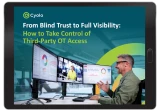Table of Contents
Why Critical Industries Prioritize Safety and Availability
In critical industries like energy, utilities, and oil and gas and in industrial sectors such as manufacturing and mining, the top priorities of any organization will always be safety and systems availability. This is easy to understand, as worker safety in potentially dangerous facilities simply must be paramount. Only slightly less crucial is availability, or the proportion of time that production equipment and systems are operational. Downtime, or lack of availability, can cause not only enormous financial losses but also the disruption of essential services, such as water treatment, oil refining, or the production of basic goods. It should also be noted that safety and availability are in many cases related; for instance, a sudden, unexpected shutdown of equipment could lead to worker injuries or other serious physical damage.
Cybersecurity Gains Steam Across Industries
Compared to safety and availability, cybersecurity has traditionally ranked as less of a concern for critical industries. This is at least partially because, until recently, most operational technology (OT) environments were air-gapped. Such isolation largely prevented compromise or infiltration and allowed plant managers and other stakeholders to focus on other priorities.
But, as discussed in depth in the research report, Managing Access & Risk in the Increasingly Connected OT Environment, more OT systems are now being connected to internal networks and even the internet. While this connectivity has a wide range of benefits, it also means that more attention must now be devoted to securing OT environments. As just one example of this growing concern, 86% of respondents to a 2023 Fortinet survey on cybersecurity in the oil and gas industry said their organization is planning to implement new solutions to address cyber risks to OT.
Does More Security Mean Less Safety or Availability?
So, what is the relationship between safety and availability on the one hand and cybersecurity on the other? Longtime OT operators might argue that cybersecurity is primarily at odds with safety and availability. And it’s true that some security solutions – particularly those that were built for the world of information technology (IT) – can disrupt operations, causing delays or downtime that both hurt the bottom line and put safety at risk.
On the other side of the coin, security professionals accustomed to solving IT challenges may initially be stymied by the distinctive requirements of OT environments, which make many security best practices difficult or even impossible to follow. For instance, patching is a standard way to keep IT networks and systems secured against the latest cyberthreats. But, due to the importance of availability, OT systems cannot simply be shut down to accommodate patching exercises or other updates. Similarly, vulnerability scanning is common in IT scenarios but can create friction or cause unacceptable delays in OT.
How to Ensure Safety, Availability, AND Security in Critical Industries
Fortunately, what might at first seem like an unbridgeable gulf between security (the IT priority) and safety and availability (the OT priorities) is not actually so wide. With the right approach and solutions, organizations can protect their OT environments from rising cyberthreats while also fulfilling vital needs around safety and availability.
Cyolo PRO (Privileged Remote Operations) is a remote access solution built for the realities of the modern OT environment. Unlike tools designed for IT and then adjusted after the fact for OT, Cyolo PRO was created with safety and availability in mind from the start. Let’s explore a few examples of what this means in practices.
First, Cyolo PRO can be deployed without major infrastructure changes or operational interruptions. This alone is a significant improvement over the many secure access solutions that demand extensive reconfiguring of existing infrastructure, which can be a non-starter for organizations in critical industries.
Second, Cyolo PRO’s unique decentralized architecture reduces latency and facilitates fast, reliable connections regardless of user or resource location. Speedy connections not only keep users happy but also enable the true real-time activity that critical industries depend on.
Finally, Cyolo PRO enables secure access, including multi-factor authentication (MFA), to the homegrown and legacy systems that are frequently present in OT environments. This is crucial because legacy systems by definition cannot be patched or updated and are therefore often targeted by attackers. By sealing off this vulnerable entry point, Cyolo PRO improves security and simultaneously helps ensure that threat actors cannot put safety and operational agility at risk via an attack on legacy infrastructure. Securing access to legacy systems may also be a requirement of the regional and industry-focused compliance mandates that organizations must adhere to.
Conclusion
Safety and availability are unlikely to lose their places as the top two priorities of organizations in critical industries; however, cybersecurity is a rising concern that will only continue to grow. By choosing security solutions that are built to accommodate safety and availability requirements, organizations can satisfy all relevant stakeholders and keep operations running smoothly into the future.
Discover the Benefits of Cyolo PRO (Privileged Remote Operations)

Jennifer Tullman-Botzer
Author
Jennifer Tullman-Botzer has over a decade of experience in cybersecurity marketing and is as tired as you are of hackers-in-hoodies stock images. She joined Cyolo in 2021 and currently serves as Head of Content. Prior to Cyolo, Jennifer worked in a variety of marketing roles at IBM Security. She lives in Tel Aviv, Israel.

Subscribe to Our Newsletter







